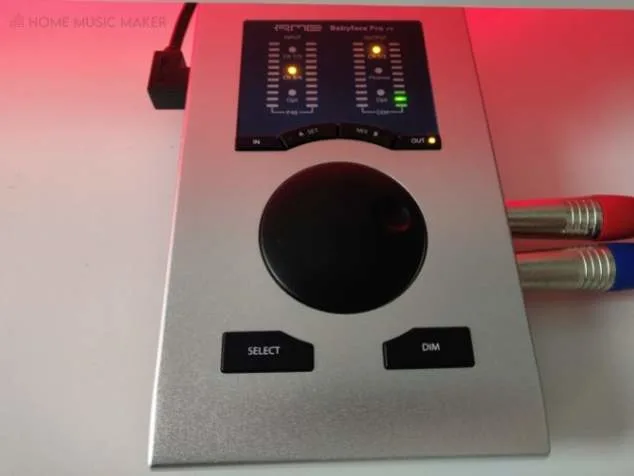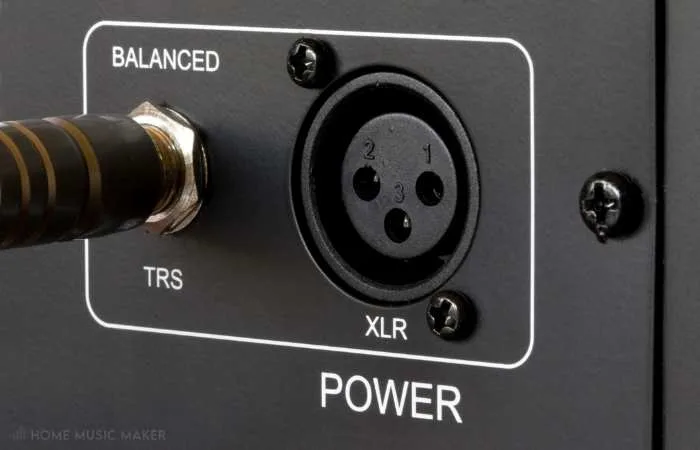If you’d like to use phantom power to feed your condenser microphones, having an audio interface is probably the most convenient way to do it. Even though phantom power is found in DI boxes and audio mixers, it seems the most practical in the audio interface.
If you are dipping your toes into the home recording world, your mind may be bombarded with many questions. You may have thought that simply buying a microphone would suffice. Still, after brief research online, you find terms like audio interface and phantom power popping up, and you’re not sure what they mean.
Are the two the same thing? And which one do you actually need in your home recording setup?
If you want to make sure you know what’s what, carry on reading.
What Is An Audio Interface?
An audio interface is a multi-purpose box intended for recording and mixing music through your computer.
The audio interface allows you to take your microphone or guitar signal and transfer it into a medium that your computer can read. So it takes your analog signal and converts it into a digital one (1s and 0s) so that you can then further manipulate it in your DAW.

Of course, the audio interface can do so much more, and loads of sophisticated technology are at play here.
We won’t bother ourselves with technical details but instead focus on practical knowledge that can help you in better using the device and all its little perks.
Are you looking for an excellent Audio Interface? Click Here for this top pick!
Do Audio Interfaces Have Phantom Power?
You might wonder why are terms audio interface and phantom power are intertwined. The answer is quite simple, actually – each audio interface has phantom power built into it. I’m tempted to say “most of the audio interfaces,” but honestly, I’ve never stumbled upon one that doesn’t have it.
So yes, each audio interface comes equipped with the option to engage this feature, but why is phantom power necessary in the first place?
Why Do You Need Phantom Power?
There are three types of microphones – dynamic, ribbon, and condenser.
Dynamic mics and ribbon mics can work fine on their own (you simply plug them in and record). However, the condenser microphone needs some extra electrical power to work correctly.
This is precisely what the phantom power supply is designed to do – feed condenser microphones additional current so they can work on the optimal level.

Now, phantom power is not a significant engineering problem, and you can easily build one into almost any device. And that’s exactly what all manufacturers do. You’ll rarely (actually never) find a dedicated phantom power supply.
Historically, it’s been placed in mixing consoles, DI boxes, and lately audio interfaces.
Most devices won’t have a label named “phantom power” on them, but instead, you’re more likely to find ’48 V’ near the switch or a button. This means that 48 volts of power are sent through the cable to the microphone and thus the label.
What Does Audio Interface Do Besides Providing Phantom Power?
As we’ve said at the beginning of the article, an audio interface is a multi-purpose toolbox, so what does it do?
Audio Interface Increases Sound Quality
Having an audio interface in your recording setup can help you achieve a greater sound quality in two ways.
First of all, an audio interface is a high-quality, dedicated external sound card. This means that it works loads better than your average multi-purpose sound card that comes with your motherboard. It’s built specifically for audio having the highest sound quality in mind.
Secondly, an audio interface has high-quality preamps and converters. This means that your recorded signal will be of the highest quality supported by your recording gear (microphones, guitars, etc.).
This brings us to the next big perk of having an audio interface.
You’ll Get Better Recordings
Not only will you have the option of adjusting input levels and making sure you get clean and distortion-free recordings, but you’ll also have the option of recording multiple inputs simultaneously.
Depending on the model, you can record a single source in stereo (with two microphones) or record yourself and your friend jamming out together.
This presumes that you’ll get a model with two inputs which are not mandatory for beginners but an excellent addition since they’re pretty affordable.
If you grow your producing passion even further, you can get one with 4, 8 or even 16 inputs for recording a full drum kit or a whole band at once.
Specifically designed converters will also ensure that your recordings sound clean and pristine with as little unwanted noise as possible.
Multiple Outputs
Having multiple outputs is one of the audio interface’s greatest strengths.
This allows you to connect multiple devices to monitor your mixes. If you want to check your mix on some other speakers or headphones (and btw you should), you won’t have to disconnect your main monitors.
This is a significant time and nerve saver. Most budget models have the headphone out, which you can use to plug in headphones or even another pair of speakers. You’ll also get a separate volume for the headphone out so you can adjust it to taste and need.
No Latency When Recording
Latency is a real party spoiler when it comes to recording sessions. You’ll basically be left with no option but to record without listening to what you’re doing.
Latency is the lag between you hitting the note or singing and coming out of the speakers. You may sing a note and hear the playback 2 seconds afterward. This can affect your performance and frankly kill all the fun during the recording process.
Luckily, you can set the buffer size to the lowest value with the audio interface and completely eliminate latency issues.
Where Else Can You Find Phantom Power?
The phantom power supply can be found on many audio devices.
If the audio interface really isn’t your thing, but you still want to use a condenser microphone, you can perhaps use a DI box.
You can also find phantom power in audio mixers (even the small, budget ones) and analog mixing consoles.
Related Questions
Why Does a Condenser Microphone Require a 48v Phantom Power Supply?
Condenser microphones have active electronics and thus need additional power to work. That electrical current is required to reduce the high impedance these mics operate on.
What Happens if You Don’t Use Phantom Power on A Condenser Mic?
Without phantom power supplies, your condenser mic simply won’t work, meaning it won’t capture any sound. Other than that, you don’t need to worry about it malfunctioning or something similar.
Why Is It Called ‘phantom Power’?
Most probably because you don’t need to use an additional cable to feed the microphone with power. It’s all done through an XLR cable that you use anyway. It may look like the power is coming ‘out of nowhere’ and thus the term ‘phantom power.’
What Is the Purpose of Phantom Power on A Mixer?
You may want to use a condenser microphone in a live setting, so it’s nice to have that as an option in your audio mixer.
Should You Turn on Phantom Power Before Plugging in A Mic?
No, it’s generally advised first to plug in a mic and then turn the phantom power on, making sure that the gain knob is all the way down. The reverse goes when it comes to unplugging. First, turn off the phantom power and only then unplug the mic. You don’t want to risk damaging your gear by having a loud popping sound rip through your system.
Can You Damage a Ribbon Microphone with Phantom Power?
Probably not, but it’s not advised to use the phantom power with anything other than condenser mics. The same goes for a dynamic microphone as well.
Do USB Condenser Mics Need Phantom Power?
USB mics are already fed the desired current through the USB cable so that you won’t need phantom power.
What Is the Key difference Between a USB Mic and An XLR Mic?
The main difference is that a USB mic is strictly designed to be used with computers, so you can’t actually take them out of the studio without a proper setup to plug it in.
Are you looking to upgrade your audio interface? Check out our Top 12 Best Audio Interfaces here!

 Want to connect with other music producers for help and guidance?
Want to connect with other music producers for help and guidance?